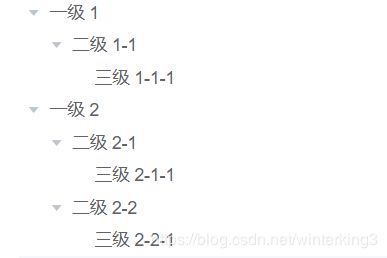Elasticsearch笔记(十三) ES 存储树形结构 整合Spring Data Elasticsearch
ES存储树形结构 整合Spring Data Elasticsearch
- 1 前言
- 左右值法
- parentId
- parentId+path
- 优化parentId+path
- 2 验证想法
- 下面设计一个通用数据字典表结构
- 写DSL,测试查询直属下级节点数量
- 定义实体类
- 1 实体父类PiggBaseEntity
- 2 字典实体PiggDataNode
- 3 Path实体类
- 4 service层的方法-统计子孙节点个数
- 5 测试方法
1 前言
在工作中,我们经常遇到父子结构的数据, 比如省市县, 部门人员, 数据字典, 菜单结构等.
我们在设计表结构时, 一定要设计好, 否则查询会比较耗时.
通常设计父子结构的表时有如下方案:
左右值法
在节点里维护左右值, 查询子孙节点比较方便, 但是维护比较麻烦, 数据也不直观
parentId
每一行数据保存父亲节点的Id, 这样查直属下级比较方便, 但是查询子孙节点, 递归很慢
parentId+path
在第2点基础上加上path, path是所有祖先节点的id,用逗号分隔.
比如有如下结构:

那么"三级 2-1-1"的path就会是"2,2-1,2-1-1",
你要统计"一级2"所有子孙节点个数时, 你或许会这么做
在用MySQL时: select count(1) from tablename where path like ‘2,%’
在用ES时, 你可能
GET tree/_search
{ "query": {
"prefix" : { "path" : "2," }
}
}
但数据量大时, MySQL的like和ES的prefix会比较慢.
优化parentId+path
在ES里, 将path设置为Nested类型, 它包含id,level这2个子字段
#这里用ancestorId(祖先ID)表示path的意思
"ancestorId":{
"type":"nested",
"properties": {
"id": { "type": "keyword" },
"level": { "type": "keyword" }
}
}
那"三级 2-1-1"的ancestorId值为:
[
{
"level":1,
"id":"2"
},
{
"level":2,
"id":"2-1"
},
{
"level":3,
"id":"2-1-1"
}
]
2 验证想法
上面的想法只是我根据自己浅薄知识的猜测, 还是先验证下是否可行吧.
下面设计一个通用数据字典表结构
PUT /pigg_data_node
PUT /pigg_data_node/_mapping/_doc
{
"properties":{
"id":{
"type":"keyword"
},
"parentId":{
"type":"keyword"
},
"ancestorId":{
"type":"nested",
"properties":{
"id":{
"type":"keyword"
},
"level":{
"type":"keyword"
}
}
},
"level":{
"type":"keyword"
},
"dataName":{
"type":"keyword"
},
"dataValue":{
"type":"keyword"
},
"dataType":{
"type":"keyword"
},
"extendInfo":{
"type":"keyword",
"index":false
},
"order":{
"type":"keyword"
},
"remark":{
"type":"keyword",
"index":false
},
"status":{
"type":"keyword"
},
"createTime":{
"type":"date"
},
"creator":{
"type":"keyword"
},
"updateTime":{
"type":"date"
},
"updater":{
"type":"keyword"
}
}
}
写DSL,测试查询直属下级节点数量
GET /pigg_data_node/_doc/_count
{
"query":{
"bool":{
"must":[
{
"term":{
"level":{
"value":2
}
}
},
{
"nested":{
"query":{
"bool":{
"must":[
{
"term":{
"ancestorId.id":{
"value":"5e9dddad551f2215bee100e8"
}
}
},
{
"term":{
"ancestorId.level":{
"value":1
}
}
}
]
}
},
"path":"ancestorId"
}
}
]
}
}
}
定义实体类
1 实体父类PiggBaseEntity
package com.pigg.study.tree.common.entity;
import lombok.Data;
import org.springframework.data.annotation.Id;
import org.springframework.data.elasticsearch.annotations.Field;
import org.springframework.data.elasticsearch.annotations.FieldType;
import java.util.Date;
@Data
public class PiggBaseEntity {
@Id
@Field(type = FieldType.Keyword)
private String id;
@Field(type = FieldType.Keyword)
private String status = "1";
@Field(type = FieldType.Keyword)
private String creator;
@Field(type = FieldType.Date)
private Date createTime;
@Field(type = FieldType.Keyword)
private String updater;
@Field(type = FieldType.Date)
private Date updateTime;
}
2 字典实体PiggDataNode
package com.pigg.study.tree.common.entity;
import com.pigg.study.tree.entity.Path;
import lombok.Data;
import org.springframework.data.annotation.Transient;
import org.springframework.data.elasticsearch.annotations.Document;
import org.springframework.data.elasticsearch.annotations.Field;
import org.springframework.data.elasticsearch.annotations.FieldType;
import java.util.List;
@Data
@Document(indexName = "pigg_data_node", type = "_doc", shards = 1, replicas = 0)
public class PiggDataNode extends PiggBaseEntity{
@Field(type = FieldType.Keyword)
private String parentId;
@Field(type = FieldType.Nested)
private List<Path> ancestorId;
@Field(type = FieldType.Keyword)
private short level;
@Field(type = FieldType.Keyword)
private String dataName;
@Field(type = FieldType.Keyword)
private String dataValue;
@Field(type = FieldType.Keyword)
private String dataType;
@Field(type = FieldType.Keyword)
private short order;
@Field(type = FieldType.Keyword, index = false)
private String remark;
@Field(type = FieldType.Keyword, index = false)
private String extendInfo;
@Transient
private List<PiggDataNode> children;
}
3 Path实体类
package com.pigg.study.tree.entity;
import lombok.AllArgsConstructor;
import lombok.Data;
import lombok.NoArgsConstructor;
import org.springframework.data.elasticsearch.annotations.Field;
import org.springframework.data.elasticsearch.annotations.FieldType;
@Data
@NoArgsConstructor
@AllArgsConstructor
public class Path {
@Field(type = FieldType.Keyword)
private short level;
@Field(type = FieldType.Keyword)
private String id;
}
4 service层的方法-统计子孙节点个数
/**
* 获取直接下级节点个数(有效的)
* @param parentId
* @return
*/
@Override
public Long countByParentId(Path parentId) {
return countByAncestorIdWithCondition(parentId, true, "1", null);
}
/**
* 获取直接下级节点个数(全部状态的)
* @param parentId
* @return
*/
@Override
public Long countByParentIdOfAllStatus(Path parentId) {
return countByAncestorIdWithCondition(parentId, true,null, null);
}
/**
* 获取所有子孙节点个数(有效的)
* @param ancestorId
* @return
*/
@Override
public Long countByAncestorId(Path ancestorId) {
return countByAncestorIdWithCondition(ancestorId, false,"1", null);
}
/**
* 获取所有子孙节点个数(全部状态的)
* @param ancestorId
* @return
*/
@Override
public Long countByAncestorIdOfAllStatus(Path ancestorId) {
return countByAncestorIdWithCondition(ancestorId, false,null, null);
}
/**
* 根据祖先ID和条件统计节点个数
* @param ancestorId
* @param onlyNextLevel
* @param status
* @param status
* @return queryBuilder
*/
@Override
public Long countByAncestorIdWithCondition(Path ancestorId, Boolean onlyNextLevel, String status, QueryBuilder queryBuilder) {
BoolQueryBuilder boolQueryBuilder = QueryBuilders.boolQuery();
if (onlyNextLevel) {
boolQueryBuilder.filter(QueryBuilders.termQuery("level", ancestorId.getLevel() + 1));
}
if (!StringUtils.isEmpty(status)) {
boolQueryBuilder.filter(QueryBuilders.termQuery("status", 1));
}
if (queryBuilder != null) {
boolQueryBuilder.filter(queryBuilder);
}
BoolQueryBuilder boolQueryBuilderForNested = QueryBuilders.boolQuery();
boolQueryBuilderForNested.filter(QueryBuilders.termQuery("ancestorId.id", ancestorId.getId()));
boolQueryBuilderForNested.filter(QueryBuilders.termQuery("ancestorId.level", ancestorId.getLevel()));
boolQueryBuilder.filter(QueryBuilders.nestedQuery("ancestorId", boolQueryBuilderForNested, ScoreMode.None));
SearchQuery searchQuery = new NativeSearchQueryBuilder()
.withQuery(
boolQueryBuilder
).build();
System.out.println(searchQuery.getQuery().toString());
return elasticsearchTemplate.count(searchQuery, PiggDataNode.class);
}
5 测试方法
import com.pigg.study.tree.Application;
import com.pigg.study.tree.common.entity.PiggDataNode;
import com.pigg.study.tree.dao.TestDao;
import com.pigg.study.tree.entity.Path;
import com.pigg.study.tree.entity.TestEntity;
import com.pigg.study.tree.service.PiggDataNodeService;
import org.junit.runner.RunWith;
import org.springframework.beans.factory.annotation.Autowired;
import org.springframework.boot.test.context.SpringBootTest;
import org.springframework.test.context.junit4.SpringRunner;
import java.util.ArrayList;
import java.util.Date;
import java.util.List;
import java.util.Optional;
@RunWith(SpringRunner.class)
@SpringBootTest(classes = Application.class)
public class Test {
@Autowired
TestDao testDao;
@Autowired
PiggDataNodeService piggDataNodeService;
@org.junit.Test
public void test(){
//create
TestEntity testEntity1 = new TestEntity();
testEntity1.setId("4");
testEntity1.setName("test4444");
testDao.save(testEntity1);
Boolean ifExist = testDao.existsById("5");
System.out.println(ifExist);
}
@org.junit.Test
public void testAdd(){
PiggDataNode dataNode = new PiggDataNode();
dataNode.setLevel((short) 1);
dataNode.setDataName("部门-1");
dataNode.setDataValue("dept-1");
dataNode.setDataType("dept");
dataNode.setOrder((short) 1);
piggDataNodeService.save(dataNode);
System.out.println(dataNode.getId());
}
@org.junit.Test
public void testAddList(){
List<PiggDataNode> dataNodes = new ArrayList<>();
for (int i = 1; i< 10; i++){
PiggDataNode dataNode = new PiggDataNode();
dataNode.setLevel((short) 1);
dataNode.setDataName("部门-" + i);
dataNode.setDataValue("dept-"+ i);
dataNode.setDataType("dept");
dataNode.setOrder((short) i);
dataNodes.add(dataNode);
}
piggDataNodeService.save(dataNodes);
dataNodes.stream().forEach(a -> System.out.println(a.getId()));
}
@org.junit.Test
public void testAddList2(){
List<PiggDataNode> dataNodes = new ArrayList<>();
String parentId = "5e9dddad551f2215bee100e8";
for (int i = 1; i< 10; i++){
PiggDataNode dataNode = new PiggDataNode();
dataNode.setLevel((short) 2);
dataNode.setDataName("部门-1-" + i);
dataNode.setDataValue("dept-1-"+ i);
dataNode.setDataType("dept");
dataNode.setOrder((short) i);
dataNode.setParentId(parentId);
dataNode.setCreateTime(new Date());
List<Path> ancestorId = new ArrayList<>();
ancestorId.add(new Path((short) 1, parentId));
dataNode.setAncestorId(ancestorId);
dataNodes.add(dataNode);
}
piggDataNodeService.save(dataNodes);
dataNodes.stream().forEach(a -> System.out.println(a.getId()));
}
@org.junit.Test
public void testAddList3(){
List<PiggDataNode> dataNodes = new ArrayList<>();
String parentId = "5e9ddf58551f630a85e96a2c";
for (int i = 1; i< 10; i++){
PiggDataNode dataNode = new PiggDataNode();
dataNode.setLevel((short) 3);
dataNode.setDataName("部门-1-1-" + i);
dataNode.setDataValue("dept-1-1-"+ i);
dataNode.setDataType("dept");
dataNode.setOrder((short) i);
dataNode.setParentId(parentId);
List<Path> ancestorId = new ArrayList<>();
ancestorId.add(new Path((short) 1, "5e9dddad551f2215bee100e8"));
ancestorId.add(new Path((short) 2, "5e9ddf58551f630a85e96a2c"));
dataNode.setAncestorId(ancestorId);
dataNodes.add(dataNode);
}
piggDataNodeService.save(dataNodes);
dataNodes.stream().forEach(a -> System.out.println(a.getId()));
}
@org.junit.Test
public void testCountByAncestorId() {
String parentId = "5e9dddad551f2215bee100e8";
Long count = piggDataNodeService.countByAncestorId(new Path((short) 1, parentId));
System.out.println(count);
}
@org.junit.Test
public void testCountByParentId() {
String parentId = "5e9dddad551f2215bee100e8";
Long count = piggDataNodeService.countByParentId(new Path((short) 1, parentId));
System.out.println(count);
}
}